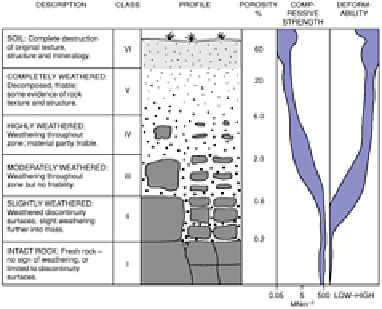Environmental Engineering Reference
In-Depth Information
Finally, chemical weathering is also enhanced by certain biological processes.
Decomposition inflates soil concentrations of CO
2
, potentially increasing solution rates,
and secretes biochemical
chelating agents
which aid the solution of otherwise stable
cations.
The chief products of chemical weathering are stable quartz - the principal ingredient
of siliciclastic sediments - clay minerals and dissolved products. Clay minerals are
capable of further weathering which enhances silica removal, particularly in warm,
humid environments. Residual or redeposited minerals create economically viable
sources of alumina (
bauxite
) and iron (
laterite
), etc.
Gibbsite
and to a lesser extent
kaolinite
, found in Wales and Cornwall, are assumed to be relic Tertiary humid-tropical
weathering clay minerals.
WEATHERING LANDFORMS
Landforms of physical and chemical weathering range from residual, less weathered or
even non-weathered bedrock to deep,
in situ
weathered debris sheets. Survival depends
on the balance between weathering and removal by mass wasting or erosion (Figure
13.10).
Saprolite
is a fine-grained or amorphous chemical weathering product with no
direct physical equivalent. General rock debris or
regolith
is non-specific, but
felsenmeer
or
block
-
field
, found on low-angled surfaces, is more closely associated with
cryofracture.
Inselbergs
(Plate 13.6) and
core
-
stone
granite tors are often relics of
intense weathering in late-Tertiary tropical climates, exhumed as climates changed during
the Quaternary. The survival of thick weathered profiles and core stones below glacigenic
sediments indicates that glacial erosion may not remove all weathered products right
down to the weathering front or
etch front
. On a grand scale, calcareous (limestone)
solution-carbonation weathering is so distinctive as to justify its own subdiscipline of
karst geomorphology. Principal landforms are shown in the box, p. 267, Figure 1.
Figure 13.10
Weathering profile and some geotechnical
properties.
Source: Partly after Dearman (1974).

